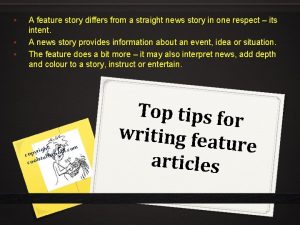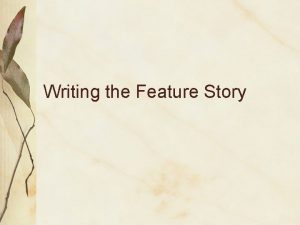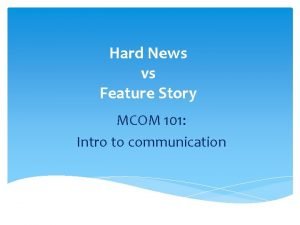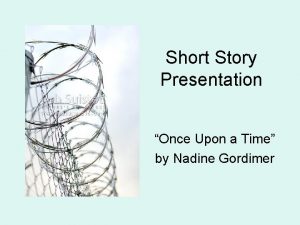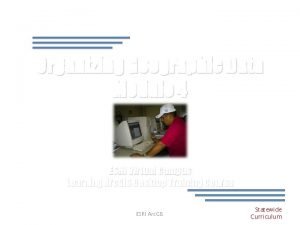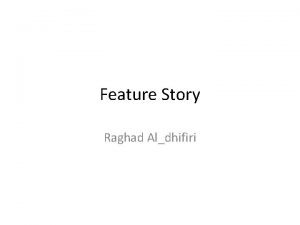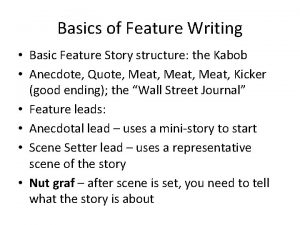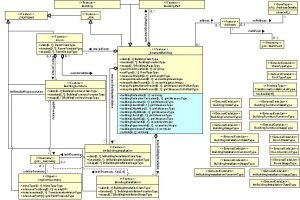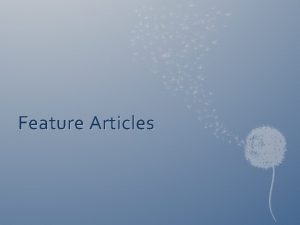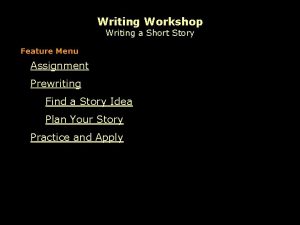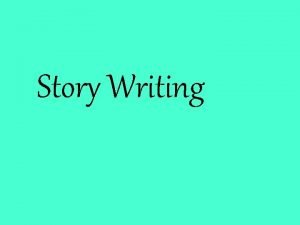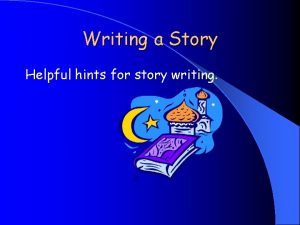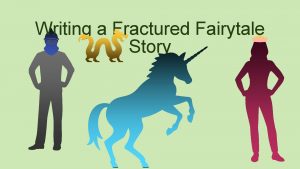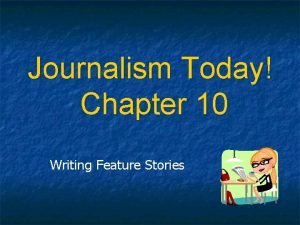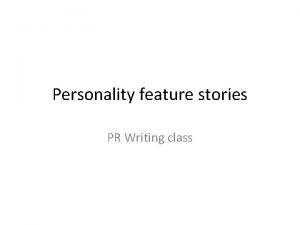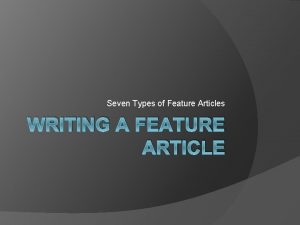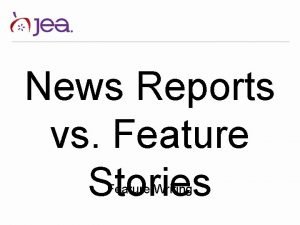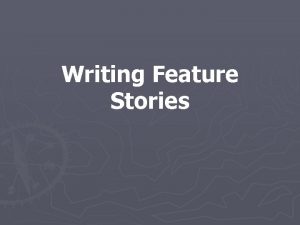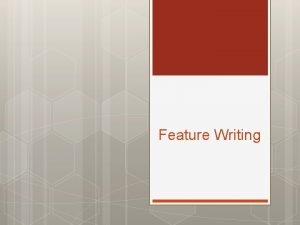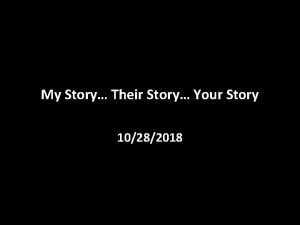Writing the Feature Story What is feature writing














































- Slides: 46

Writing the Feature Story

What is feature writing? s Read more like nonfiction short stories. s Have a beginning, middle and end s Focus on facts likely to amuse, entertain, inspire. s Because of their emphasis, they are also called human interest or color stories.

Borrow techniques from fiction s s s s Use extensive description Sensory details Quotations Anecdotes Characterization Setting Plot structure

But they’re not fiction s They must be: s Factual s Original s Fair s Balanced s Objective

Types of feature stories

Personality Profile s Describe interesting people s Don’t just list their accomplishments or important dates in their career. s Reveal a person’s character s Watch the person at home, work, etc. s Interview friends, family, co-workers s Your goal: To make the reader feel like they actually know the person featured.

Historical features s Commemorate important dates s How do you write historical features? s First, do your research. s Find people who were there or took part in the events.

Adventure features s Describe unusual and exciting experiences s Key are: s Quotations s Descriptions

Seasonal features s Stories about Christmas, Easter, Valentine’s Day, Thanksgiving, etc. s The hard part: Coming up with a new angle.

Explanatory features s Provide a detailed description or explanation of things in the news. s They may examine an organization, activity or trend.

You’re telling a story Beginning (lead and nut graph) Middle Q+T+Q+T End Here’s the formula…

Formula for Features … (or writing on the QT) Delayed lead Nut graph paragraph that tells what the story is about – basically the 5 Ws and H info Middle Quote + Transition + Quote + Transition … End perhaps full circle referring back to lead or end on a quote, or a strong image, or it may suggest the future.

STOP! Read “Mama” Pay attention to the writing. When you finish, take notes on the General tips and see your writing assignment at the end. (Leads section can wait until you have finished your assignment. )

GENERAL TIPS

1. Immediately grab reader’s attention. 2. Give reader hard facts so they will continue reading. 3. Each paragraph should build on previous one. 4. Don’t write two leads, or be repetitive. 5. Don’t write a “warm-up paragraph. ” Cut to the chase.

Do: Be specific & concrete (especially with descriptions). Convey energy & action.

Don’t: Use too much detail. Use abstract/general language. Be vague.

Guidelines for Writing Features • Show people doing things • Let them talk • Underwrite: Let and dialogue actions carry the piece. • Keep the piece moving

Landmines to Writing Features (Yes, they can blow up in your face!) Overwriting: Trying to hard for effect Over-reporting: one good anecdote/ quote

Landmines cont. Concern for subject: be fair – don’t sacrifice facts for effect Bogging down in background Lack of guts: give full profile (beauty and blemishes)

Assignment 1: 300 -word minimum, typed. May take a list form. What is effective about the story-telling in the personality profile “Mama”? With what you know now, write a critique of the writing: Well done? How so? What could improve? How?

Assignment 2: Your story Write a personality profile. Choose your subject Make an interview appointment Research Write questions Put in order – easy ones first Bring them to class tomorrow!

JOURNALISM LEADS How To Write Amazing Leads

“The most important sentence in any article is the first one. If it doesn’t induce the reader to proceed to the second sentence, your article is dead. ” (William Zinsser, On Writing Well)

Their Purpose A “lead” or “lede” grabs the reader’s attention. It is the most important part of an article. If it is not good, risk losing reader.

What is a Feature Lead? More “poetic. ” A natural extension of the story. Doesn’t have to be the “what, ” but has to entice reader. Don’t follow as many rules as news stories. Relevant, fits mood, and grabs attention More types than news leads.

Feature Leads Include: 1. Allusion (Literary and Historical) 2. Contrast 3. Pun 4. Description (Sight, Person, & Event) 5. Capsule (Punch Lead) 6. One Word 7. Miscellaneous Freak Leads

8. Parody Lead 9. Direct Address 10. Staccato 11. Anecdotal Lead 12. Sequence (Narrative) 13. Then and Now 14. Question 15. Quote

Allusion (Literary) • Relates person/event to character/event • in literature. Example: – “To have been ordered into battle to attack a group of windmills with horse and lance would have seemed to Joe Robinson no more strange an assignment than the one given to him Thursday by Miss Vera Newton. . . ” Allusion to Don Quixote

Allusion (Historical) Relates person/event to character/event in history. Example: “Washington’s trip across the Delaware was child’s play compared with Dave Jason’s span of the Big Lick River. ”

Contrast Lead Compares extremes Example: “His wealth is estimated at $600 million. He controls corporations operating in more than 20 nations. Yet he carries his lunch to work in a brown paper bag and wears the latest fashions form Sears and Roebuck’s bargain basement. ”

Pun Lead Uses a play on words to capture reader. Example: “Western High’s trash collectors have been down in the dumps lately. ”

Description Lead (Sight) Detailed description of what is seen. Example: “The road to Nsukka in eastern Nigeria is rutted and crumpled, the aging asphalt torn like ragged strips of tar paper. ”

Description Lead (Person) Detailed description of a person, usually the main character of the story. Example: “The imam begins his trek before dawn, his long robe billowing like a ghost through empty streets. ”

Description Lead (Event) Detailed description of an event. Example: “The air inside the darkened gymnasium is heavy with the heat of an uncommonly prolonged North Carolina summer. ”

Capsule (Punch) Lead Blunt, explosive statement to summarize article. Example: “The Beatles are back!”

One Word Lead Blunt, explosive word to summarize article. Example: “Awesome. That’s the best term to describe the Rattler girls’ basketball team, which notched its 15 th consecutive win Friday night. ”

Miscellaneous Freak Leads Begin with uncommon or odd statement. Example: “‘For sale: one elephant. ’ The City Park Commission is thinking about inserting that ad in the newspaper. ”

Parody Lead Copies well-known proverb, quotation, or phrase. Example: “Whisky, whisky everywhere, but ’nary a drop to drink. Such was the case at the City Police Station yesterday when officers poured 100 gallons of bootleg moonshine into the sewer. ”

Direct Address Lead Speaks directly to reader on appealing subject. Example: “Do not expect any pity from the weatherman today. He forecasts a continuation of the bitter Arctic cold wave that has gripped the city for a week. ”

Staccato Lead Jerky, exciting phrases used if facts justify it. Example: “Midnight on the bridge…a scream…a shot…a splash…a second shot…a third shot. ”

Anecdotal Lead Uses event to represent universal experience. Example: “It was 1965 and the Dallas Cowboys were making good use out of an end-around play to Frank Clarke, averaging 17 yards every time a young coach named Tom Landry pulled it out of his expanding bag of tricks. ”

Sequence (Narrative) Lead Puts reader in midst of action. Example: “On a frozen morning in hilly rural Wisconsin, the dead deer lay stacked in a pile, like so much garbage. Big and brawny, these whitetail bucks and does should be prizes. But the hunters who shot them are afraid to take them home. ”

Then and Now Lead Shows progress over time. Example: “The Rio Grande once flowed through there, a wide and robust river surging between steep banks as it followed a southward course hugging the state’s curvy profile. ”

Question Lead Use when story has direct relevance to reader. “You think you have it bad? Consider Ron Mullens. Once vice president of a major real estate corporation, today he’s penniless. ”

Quote Lead Usually avoid them. Quote should capture theme of story. Example: “‘People usually have two completely different opinions of what my life must have been like growing up, ” said actress Joely Fisher, 28, a child of the short, unhappy union between Connie Stevens, the sex kitten of 1950’s TV, and Eddie Fisher, the singer and former matinee idol.
 How does a feature story differ from a straight news story
How does a feature story differ from a straight news story Staccato lead journalism examples
Staccato lead journalism examples What is news feature
What is news feature Short story once upon a time
Short story once upon a time Feature dataset vs feature class
Feature dataset vs feature class Isolated feature combined feature effects
Isolated feature combined feature effects Hát kết hợp bộ gõ cơ thể
Hát kết hợp bộ gõ cơ thể Frameset trong html5
Frameset trong html5 Bổ thể
Bổ thể Tỉ lệ cơ thể trẻ em
Tỉ lệ cơ thể trẻ em Voi kéo gỗ như thế nào
Voi kéo gỗ như thế nào Tư thế worm breton
Tư thế worm breton Hát lên người ơi
Hát lên người ơi Các môn thể thao bắt đầu bằng tiếng chạy
Các môn thể thao bắt đầu bằng tiếng chạy Thế nào là hệ số cao nhất
Thế nào là hệ số cao nhất Các châu lục và đại dương trên thế giới
Các châu lục và đại dương trên thế giới Công thức tiính động năng
Công thức tiính động năng Trời xanh đây là của chúng ta thể thơ
Trời xanh đây là của chúng ta thể thơ Mật thư tọa độ 5x5
Mật thư tọa độ 5x5 Phép trừ bù
Phép trừ bù độ dài liên kết
độ dài liên kết Các châu lục và đại dương trên thế giới
Các châu lục và đại dương trên thế giới Thơ thất ngôn tứ tuyệt đường luật
Thơ thất ngôn tứ tuyệt đường luật Quá trình desamine hóa có thể tạo ra
Quá trình desamine hóa có thể tạo ra Một số thể thơ truyền thống
Một số thể thơ truyền thống Bàn tay mà dây bẩn
Bàn tay mà dây bẩn Vẽ hình chiếu vuông góc của vật thể sau
Vẽ hình chiếu vuông góc của vật thể sau Biện pháp chống mỏi cơ
Biện pháp chống mỏi cơ đặc điểm cơ thể của người tối cổ
đặc điểm cơ thể của người tối cổ V. c c
V. c c Vẽ hình chiếu đứng bằng cạnh của vật thể
Vẽ hình chiếu đứng bằng cạnh của vật thể Phối cảnh
Phối cảnh Thẻ vin
Thẻ vin đại từ thay thế
đại từ thay thế điện thế nghỉ
điện thế nghỉ Tư thế ngồi viết
Tư thế ngồi viết Diễn thế sinh thái là
Diễn thế sinh thái là Các loại đột biến cấu trúc nhiễm sắc thể
Các loại đột biến cấu trúc nhiễm sắc thể Số nguyên tố là
Số nguyên tố là Tư thế ngồi viết
Tư thế ngồi viết Lời thề hippocrates
Lời thề hippocrates Thiếu nhi thế giới liên hoan
Thiếu nhi thế giới liên hoan ưu thế lai là gì
ưu thế lai là gì Hổ sinh sản vào mùa nào
Hổ sinh sản vào mùa nào Sự nuôi và dạy con của hổ
Sự nuôi và dạy con của hổ Sơ đồ cơ thể người
Sơ đồ cơ thể người Từ ngữ thể hiện lòng nhân hậu
Từ ngữ thể hiện lòng nhân hậu
